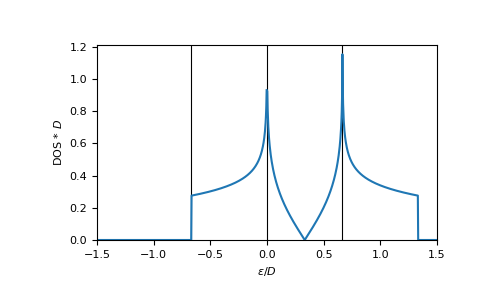gftool.lattice.kagome.dos_mp¶
-
gftool.lattice.kagome.dos_mp(eps, half_bandwidth=1)[source]¶ Multi-precision DOS of non-interacting 2D kagome lattice.
The delta-peak at eps=-2*half_bandwidth/3 is ommited and must be treated seperately! Without it, the DOS integrates to 2/3.
Besides the delta-peak, the DOS diverges at eps=0 and eps=2*half_bandwidth/3.
- Parameters
- epsmpmath.mpf or mpf_like
DOS is evaluated at points eps.
- half_bandwidthmpmath.mpf or mpf_like
Half-bandwidth of the DOS, DOS(eps < -2/3`half_bandwidth`) = 0, DOS(4/3`half_bandwidth` < eps) = 0. The half_bandwidth corresponds to the nearest neighbor hopping \(t=2D/3\).
- Returns
- dosfloat np.ndarray or float
The value of the DOS.
See also
gftool.lattice.kagome.dos_mpvectorized version suitable for array evaluations
gftool.lattice.triangular.dos_mpgftool.lattice.honeycomb.dos_mp
References
- varm2013
Varma, V.K., Monien, H., 2013. Lattice Green’s functions for kagome, diced, and hyperkagome lattices. Phys. Rev. E 87, 032109. https://doi.org/10.1103/PhysRevE.87.032109
- kogan2021
Kogan, E., Gumbs, G., 2020. Green’s Functions and DOS for Some 2D Lattices. Graphene 10, 1–12. https://doi.org/10.4236/graphene.2021.101001
Examples
Calculated integrals
>>> from mpmath import mp >>> mp.identify(mp.quad(gt.lattice.kagome.dos_mp, [-2/3, 0, 1/3, 2/3, 4/3])) '(2/3)'
>>> eps = np.linspace(-1.5, 1.5, num=1001) >>> dos_mp = [gt.lattice.kagome.dos(ee, half_bandwidth=1) for ee in eps]
>>> import matplotlib.pyplot as plt >>> for pos in (-2/3, 0, +2/3): ... _ = plt.axvline(pos, color='black', linewidth=0.8) >>> _ = plt.plot(eps, dos_mp) >>> _ = plt.xlabel(r"$\epsilon/D$") >>> _ = plt.ylabel(r"DOS * $D$") >>> _ = plt.ylim(bottom=0) >>> _ = plt.xlim(left=eps.min(), right=eps.max()) >>> plt.show()
